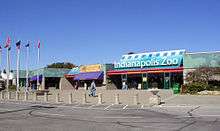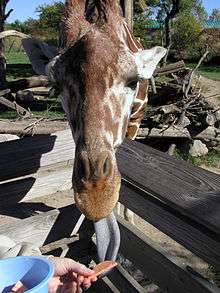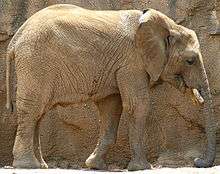Indianapolis Zoo
 Zoo entrance | |
| Date opened | April 18, 1964[1] |
|---|---|
| Location | Indianapolis, Indiana, USA |
| Coordinates | 39°46′1″N 86°10′37″W / 39.76694°N 86.17694°WCoordinates: 39°46′1″N 86°10′37″W / 39.76694°N 86.17694°W |
| Land area | 64 acres (26 ha) |
| Number of animals | 3,800 |
| Number of species | 320 [2] |
| Memberships | AZA,[3] AAM[4] |
| Website |
www |
The Indianapolis Zoo is located in White River State Park, in Indianapolis, Indiana, United States.
The Indianapolis Zoo is an institution accredited by the Association of Zoos and Aquariums (AZA) and the American Alliance of Museums as a zoo, an aquarium, and as a botanical garden. The zoo is a private non-profit organization, receiving no tax support and is supported entirely by membership fees, admissions, donations, sales, grants, and an annual fundraiser.
History
In 1944, thoughts of the Indianapolis Zoo first came to mind by a newspaper columnist named Lowell B. Nussbaum. He began to write his opinions of wanting a zoo through his column "Inside Indianapolis." It was his writing that inspired the Indianapolis people and in October 1944 the "Articles of Incorporation for the Indianapolis zoological society, INC" emerged.[5] Soon the members of this group had outlined the future plans of their zoo, one thing that the group members were adamant about; "the zoo will rely on admissions, in-park sales, contributions and memberships to support the zoo.[5]" It first opened to the public in 1964.
East 30th Street
The Indianapolis Zoo opened on April 18, 1964, at its original location on East 30th St. The official opening was two decades after the Indianapolis Zoological Society Inc. was formed and planning for the zoo started. The zoo originally featured an Asian elephant, penguins, kangaroos, foxes, raccoons, camels, bison, deer, lambs, tortoises, llamas, prairie dogs, pygmy goats, and buffalo exhibits. In 1965, the zoo became one of few in the country to employ a full-time education staff. By the 20th anniversary of the zoo, its animal collection had doubled in size. At this point, it was determined that the zoo needed a new location where it could continue to expand.
In 1982, international zoo, aquarium, and wildlife authorities gathered to determine goals for establishing the new zoo. It was determined that a zoo should not only be a place to see animals, but an institution of conservation and education. That same year, White River Gardens was declared as the new site of the zoo. The groundbreaking at the new downtown location was held in September 1985. The old zoo closed in 1987.
White River Gardens
Its current home in White River State Park was opened in 1988 with a size of 64 acres (26 ha).
After the construction of the Waters building and the Dolphin Pavilion, the zoo earned AZA accreditation as an aquarium as well as a zoo. In 1996, the Indianapolis Zoo became the first institution to be triple accredited as a zoo, aquarium and botanical garden. White River Gardens was considered a separate attraction from 1999 to 2006, but now is included as part of the zoo.[1]
The zoo hosts more than a million visitors each year and plays a role in worldwide conservation and research, including accomplishing the world’s first successful artificial insemination of an African elephant.
In 2016, the zoo moved its last polar bear named Tundra to Detroit Zoo on account of an aging exhibit. She has since died from an unknown disease.
Biomes
The Indianapolis Zoo is organized around the concept of biomes. Biomes are areas of the planet with similar climate, plants, and animals. Animals at the Indianapolis Zoo are clustered in groups with similar habitats, which define the biomes. At the Indianapolis Zoo, one can visit the five biomes listed below.
Each of the biomes participates in conservation and breeding programs.
Forests
China Display
Tropical Rainforest
Tiger forest
Red-Ruffed Lemur
Featured exhibit
Aviaries
Oceans
The Oceans exhibit opened in 2007 and features the country's largest dogshark (smooth dogfish) touch pool. This exhibit also holds the
Penguin display
Other exhibits
- Longhorn cowfish
- Ocellaris clownfish
- Bat star
- Slate pencil urchin
- Chocolate chip sea star
- Orange clownfish
- Cowrie
- The true tulip snail
- Cleaner shrimp
- Olive surgeon
- Candy stripe
- Crimson anemone
- Green sea urchin
- Blood sea star
- Powderblue surgeonfish
- Spotted unicornfish
- Vlaming’s unicornfish
- Bannerfish
- Bird wrasse
- Grunt sculpin
- Yellow watchman goby
- Neon goby
- Copperband butterflyfish
- Percula clownfish
- Bluestreak cleaner wrasse
- Christmas wrasse
- Clown tang
- Raccoon butterflyfish
- Longhorn cowfish
- Asfur angelfish
- Yellowbar angelfish
- Indian threadfin
- Black triggerfish
- Blue bumphead parrotfish
- Coral hogfish
- Atlantic trumpetfish
- Slingjaw wrasse
- Emperor snapper
- Green brittle star
- Cownose ray
- Moon jellyfish
- Purplemouth moray
- Green moray
- Cleaner wrasse
Seahorse Gallery
Marine mammals
This section features the zoo's dolphinarium as its highlight. The area contains the
Commons
Cafe on the Commons
Lemur Exhibit across from Dolphin Pavilion
Deserts

In the Deserts Dome, the transparent overhead geodesic dome allows the animals to bask in natural sunlight year-round while heating and air conditioning vents hidden in the rocks regulate the temperature. Guests will also see the
Mammals
Tortoises and Turtles
Lizards
- Blue-tongued skink
- Chuckwalla
- Grand Cayman blue iguana
- Giant plated lizard
- Inland bearded dragon
- Jamaican iguana
- Mali spiny-tailed lizard
- Rhinoceros iguana
Birds
- Double-barred finch
- Gambel's quail
- Gouldian finch
- Orange-cheeked waxbill
- Red-billed fire-finch
- Zebra finch
Snakes
- Ball python
- Blood python
- Corn snake
- Brazilian Rainbow boa
- Central American tree boa
- East African gaboon viper
- Eastern diamondback rattlesnake
- Eastern Garter snake
- Emerald tree boa
- Eyelash viper
- Green tree python
- Northern copperhead
- Western cottonmouth and plenty more rare reptiles.
Plains
Designed to be similar to Africa is the expansive Plains Biome. Upon entering the biome, visitors see:

Grassland Field
- East African crowned crane
- Common wildebeest
- Grant's zebra
- Greater kudu
- Marabou stork
- Rüppell's vulture
- White stork
Giraffes presented by Meijer
Race a Cheetah

Warthogs
African Lions presented by Harris Bank
Other African exhibits
Dolphin Adventure Pavilion

The Indianapolis Zoo's highlight is a large dolphin pavilion, which features a combination of approaches to dolphin/human interaction and some new architecture, including:
- The Underwater Dolphin Dome
Recently built is a 30-foot (9.1 m) diameter, 12-foot (3.7 m) high, underwater dome placed squarely in the middle of the dolphin performance pool – a first for U.S. zoos. Opened on Memorial Day weekend 2005, zoo visitors can now view dolphins from underneath the surface of the water.
- Marsh Dolphin Theater
On top of the water, the interior of the Marsh Dolphin Theater features a million-gallon plus pool and a coastal village scene, complete with buildings and wharf, where a dolphin show occurs everyday.
- Dolphin In-Water Adventure
The Indianapolis Zoo has the Midwest’s only in-water dolphin program for the public, allowing guests to interact with the dolphins in their exhibit.
International Orangutan Center
In early September 2012, the Indianapolis Zoo broke ground on a new, $21.5 million project known as the International Orangutan Center which will serves not only as an exhibit for guests to enjoy, but also as a research hub to help orangutan conservation.[6] The project is being partially funded by a $2,000,000 donation from the family foundation of Dean and Barbara White.[7] The exhibit houses nine orangutans [8] and features a 90-foot-tall viewing atrium and an aerial cable ride to give visitors a one of a kind view of the animals. The exhibit includes a series of cable highways to allow the orangutans to travel throughout the zoo at their leisure.[8] The exhibit opened Memorial Day weekend 2014.[8]
Rides
- Kombo Family Coaster
- White River Junction Train Ride
- Endangered Species Carousel
- SkyQuest People Mover
Conservation and research
The Indianapolis Zoo has a multifaceted approach in its conservation and research efforts. The Indianapolis Zoo is the presenter of the Indianapolis Prize, an award for animal conservation. The Indianapolis Prize includes a US$250,000 cash award and the Lilly Medal, which is presented every two years to a conservationist who has made substantial contributions toward the sustainability of an animal species or group of species. The Indianapolis Zoo participates in the Species Survival Plans (SSPs) and conservation programs of the Association of Zoos & Aquariums (AZA), the national zoo membership organization of the United States. Under the auspices of the Polly H. Hix Institute for Conservation and Research, an initiative that supports the Society’s current and future research and conservation programs, the zoo conducts research projects both in situ and ex situ on selected species. The Indianapolis Zoo also participates in three conservation and research foundations – the International Elephant Foundation (IEF), the International Iguana Foundation (IIF), and the International Rhinoceros|Rhino Foundation (IRF). The Hix Institute also supports the Tarangire Elephant Project in Tanzania to protect migration corridors from Tarangire National Park to the Ngorongoro Conservation Area. The zoo has a second partnership with the IUCN – The World Conservation Union, a conservation network. The Indianapolis Zoo, in partnership with the MacArthur Foundation, is supporting the IUCN’s project documenting the known impacts of climate change on species and habitat.
Incidents
On August 9, 2006, a truck with a shipment of 24 penguins, an octopus, and several exotic fish from the Indianapolis Zoo to Moody Gardens in Galveston, Texas, flipped over due to driver error. Several fish died immediately as their bags popped. Three gentoo penguins were killed after being hit on the roadway. As the truck was turned back over, two rockhopper penguins were found, one dead and one alive. A king penguin had an injured wing and two other penguins were in shock. The surviving animals were taken to a zoo near Tyler, Texas for treatment. Texas law requires that drivers of such a vehicle hold a commercial driver's license to legally drive it, and neither of the women driving the truck held such a license. The surviving animals eventually arrived at their destination at Moody Gardens.[9]
On November 11, 2007, a fire broke out in the Encounters area and killed several small animals. Before 4:30 am, it started in the Critter Corner building, and fire fighters arrived within five minutes. The flames were put out within 35 minutes. However, it killed three turtles, two birds, an armadillo, a snake, a colony of hissing cockroaches, several different birds (including an aracari) and other animals in that time, and more were treated at the zoo's hospital. The Critter Corner temporarily closed and the cause of the fire was due to the armadillo pushing hay bedding high enough to touch a heat light.[10]
On January 19, 2009, 15 bonnethead sharks died due to a maintenance error. When the filtration system was taken offline for cleaning, the ozone valve was turned off, to prevent the sharks from suffocating. The valve was turned back on by a staff member effectively killing them.[11]
References
- 1 2 "The History of the Indianapolis Zoo". indianapoliszoo.com. Indianapolis Zoological Society. Retrieved 19 September 2011.
- ↑ Indianapolis Zoo - Dare to Discover: OCEANS
- ↑ "List of Accredited Zoos and Aquariums". aza.org. AZA. Retrieved 19 January 2013.
- ↑ "List of Accredited Museums" (PDF). aam-us.org. AAM. Retrieved 19 January 2013.
- 1 2 INDIANAPOLIS ZOOLOGICAL SOCIETY. "The History of the Indianapolis Zoo". Retrieved 8 November 2012.
- ↑ "Indy Zoo Breaks Ground On International Orangutan Exhibit". The Indy Channel. Retrieved 30 October 2012.
- ↑ Schouten, Cory. "Zoo breaks ground on $21M orangutan exhibit". Indianapolis Business Journal. Retrieved 6 November 2012.
- 1 2 3 Milz, Mary. "Indy Zoo breaks ground on new orangutan exhibit". WTHR.com. Retrieved 30 October 2012.
- ↑ WTHR - Indianapolis News and Weather - Texas crash leaves penguins shaken
- ↑ Several Animals Killed In Indy Zoo Blaze - Indiana News Story - WRTV Indianapolis
- ↑ WTHR - 15 sharks die at Indianapolis Zoo
External links
| Wikimedia Commons has media related to Indianapolis Zoo. |
